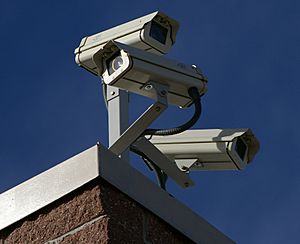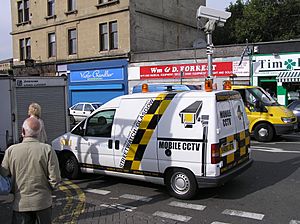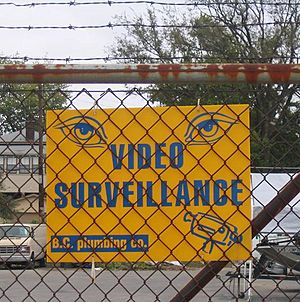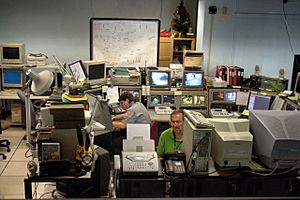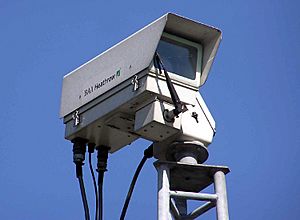Closed-circuit television facts for kids
Closed Circuit Television (CCTV) is a system that uses video cameras to send a signal to a specific set of screens. Unlike regular TV, the signal is not sent out for everyone to see. CCTV is often used for surveillance, which means watching over places that need extra security. You might see CCTV cameras in banks, casinos, airports, or even convenience stores.
CCTV systems are also used in factories. They help watch parts of a process that are far away or too dangerous for people. The growing use of CCTV in public places has led to discussions about privacy versus public safety.
Contents
What is CCTV?
CCTV stands for Closed Circuit Television. It's a way of watching and recording what happens in a specific area. The cameras send their video to monitors that only certain people can see. This is different from regular TV, where signals are broadcast widely.
CCTV systems can run all the time. Or they can turn on only when something specific happens. They are a key tool for keeping places safe and secure.
A Look Back: CCTV's History
The very first CCTV system was set up in Germany in 1942. It was used to watch the launch of V2 rockets. A German engineer named Walter Bruch designed and installed this system.
Today, CCTV is still used at rocket launch sites. It helps record flights to find out what went wrong if there's a problem. Large rockets even have cameras that send pictures back to Earth as they separate.
CCTV was first used to make banks safer. Now, it is much simpler and cheaper. This means it can even be used in home security systems.
How CCTV Helps Us Stay Safe
CCTV systems are often installed where machines could harm people. For example, on a subway train, cameras let the operator see if everyone is clear of the doors. This happens before the doors close and the train starts moving.
Amusement park ride operators also use CCTV. They can check that riders are safe before starting the ride. A camera on the back of a car can also make reversing safer. It helps the driver see things or people behind them.
Keeping an Eye on Traffic
Many cities and highways use lots of CCTV cameras. These cameras help monitor traffic. They can spot traffic jams and accidents quickly. Some of these cameras are owned by private companies. They send traffic information to drivers' GPS devices.
CCTV and Your Privacy
Some people worry about CCTV cameras. They say that too many cameras can take away our privacy. They also argue that CCTV might just move crime to other areas, instead of stopping it.
Critics sometimes call CCTV "Big Brother surveillance." This comes from a book by George Orwell called Nineteen Eighty-Four. In the book, a "telescreen" in every home watched people all the time. It's interesting that the apartment where George Orwell wrote this book now has many CCTV cameras nearby.
Other people think CCTV cameras are good. They argue that cameras watch public places, not private homes. In public spaces, they believe safety for everyone is more important than a person's privacy.
What's New with CCTV?
The first CCTV cameras were simple and black and white. They couldn't zoom in or move much. Modern CCTV cameras are very different. They are small, high-definition, and show color. They can zoom in to see tiny details.
New systems can also link cameras to computers. This allows them to track objects almost automatically. For example, they can follow movement in an area where nothing should be moving. Or they can focus on one person in a busy crowd and follow them. This tracking can even work across different cameras.
New technology also includes automatic number plate recognition. This can help find out where people or groups have been. Even more advanced is facial recognition. This technology can identify people from high-definition CCTV images. It can do this without the person even knowing they are being checked. These systems can compare thousands of faces in a database very quickly.
Images for kids
-
A crowdsourced map of CCTV cameras near Grande Arche using OpenStreetMap data.
-
The headquarters of the United Nations in New York, with cameras visible on the side of the UN General Assembly building.
-
Surveillance camera mounted on a tripod in Sunriver, Oregon.
See also
 In Spanish: Circuito cerrado de televisión para niños
In Spanish: Circuito cerrado de televisión para niños


